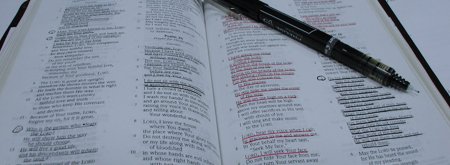Isnít the Bible Full of Contradictions?
For those of us who hold to the full trustworthiness of the Scriptures, one of the most difficult challenges is how to account for the apparent contradictions found in the Bible. So, when we are asked whether Jesus entered Jerusalem on two donkeys (Matthew 21.7) or one (Mark 11.7), and whether Jehoiachin was 8 years old when he became king (2 Chronicles 36.9) or 18 (2 Kings 24.8), we are often left floundering.
On its own, of course, the issue of Jehoiachin’s age is of little importance. It is not a central truth of the Christian faith. However, its importance is that it may cause us to doubt the full reliability of the Scriptures. If they are not trustworthy on these small points, then how can we be sure that they are trustworthy at all?
When this question is posed at the general level, I usually draw attention to the apparent contradiction in Proverbs 26.4-5. The first half of each of these two verses flatly contradict each other — “Do not answer a fool according to his folly” and “Answer a fool according to his folly” — however, the second half of each verse indicates that they are to be applied in different circumstances or for different reasons. So when the context and purpose of each verse is taken into account, there is no contradiction. This is all the more obvious as the two verses are deliberately placed together to draw out their different applications.
Many of the alleged contradictions in the Bible follow a similar pattern. What on the surface appears as a contradiction disappears once the context and purpose of the verses are taken into account.
A further point worth making is that even if you are faced with an apparent contradiction that at the time you cannot answer, then there are always two things you can say to your challenger: (1) the contradiction does not concern any major point of Christian doctrine; and (2) you will go away, study the particular point in question and then return to your questioner. Of course, it is imperative that you then do this, both to answer your challenger, and to equip yourself better for the future.
Specific problems
In relation to specific contradictions, it is worth noting that they often fall into the same category of problem. I will illustrate two of them – copyist error and misinterpretation – using the examples mentioned earlier.
1. Jehoiachin’s age: copyist error. This is the simplest type of alleged error to address. The Bible that you hold in your hands is an English translation of Hebrew, Greek and Aramaic texts. While we do not possess the original manuscripts, we do possess many thousands of copies of those original manuscripts. The process of translation begins when these different manuscripts are brought together, compared, and a definitive Greek or Hebrew version of the Scriptures is assembled.
During this process, it becomes apparent that not all of the ancient manuscripts that we possess agree in their entirety with one another. The ending of the Gospel of Mark is a good example where the manuscripts differ.
It is important to stress that the degree to which these manuscripts agree far outweighs the degree to which they disagree, and none of the discrepancies concern major theological issues. Nevertheless, both the Old and New Testaments have a range of variant readings scattered throughout. One reason for this is that scribes made errors as they copied the manuscripts across the centuries. The contradiction regarding Jehoiachin’s age is probably this type of error.
For a number of numerical discrepancies in the Old Testament, it is almost certainly this kind of copyist mistake that is responsible. Should this make us doubt that the Bible is “fully trustworthy”? No – because these kinds of textual variations are usually highlighted in our English translations, and as a result we can appreciate that the differences that exist are merely minor errors that do not impugn the reliability of the text as a whole.
2. Number of donkeys: misinterpreted text. Matthew appears to suggest that Jesus rode two animals (a donkey and its colt) into Jerusalem, while Mark and Luke make reference to just one (the colt). Which is correct? Well, if I go to the cinema with my daughter, and the following day I am asked what I did the previous night, then I am being perfectly truthful if I say either “I went to the cinema” or “My daughter and I went to the cinema”. The first statement would only contradict the second if I explicitly stated that I went to the cinema “alone”. So when Mark and Luke mention only the colt and not the accompanying donkey, there is no contradiction — merely two different ways of talking about the same event.
Apparent contradictions due to misinterpretation frequently occur because we are separated historically and linguistically from the biblical authors. In any text, we must always ask what the author is trying to convey and what theological point he is seeking to make. In Matthew’s account, at least part of his intention was to draw attention to the fulfilment of the prophecy in Zechariah. This does not mean his account contradicts that of Mark and Luke, but it does explain why he has then chosen to narrate the event in the particular way he has.
We don’t have space to address every apparent contradiction in the Bible. There are good explanations for many of them, if not all (see 101 Cleared-up Contradictions by Jay Smith and others, which is available online).
However, one stubborn discrepancy should not make us doubt the reliability of God’s Word. God has demonstrated His trustworthiness to us in so many ways that our difficulties in answering one specific point should not be allowed to trump the vast weight of evidence that exists elsewhere. We must also remember that the reliability of God’s Word is most evident as the Spirit helps us understand and apply that Word. It is not a dry textbook to be probed for inaccuracies, but a blueprint for life.
© 2007 Justin Thacker



